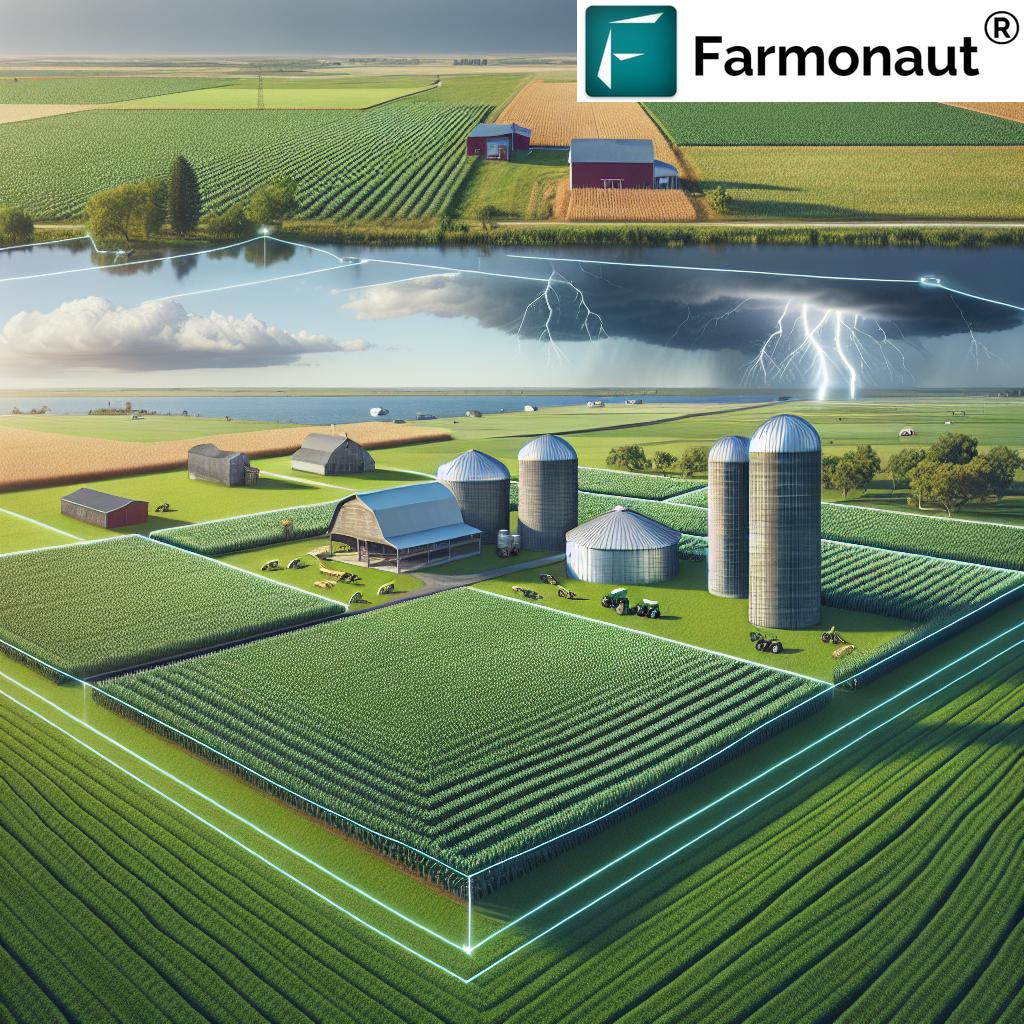Winter Wheat Harvested Acres: Shocking US Data Revealed
“In 2023, the US harvested over 25 million acres of winter wheat, a 10% increase from the previous year.”
Summary: Winter Wheat Harvested Acres – An In-Depth Analysis
Winter wheat, a key staple in global food systems, anchors agriculture in many temperate regions. Our detailed analysis explores the significance of winter wheat harvested acres, highlighting cultivation methods, the economic impact of wheat, challenges facing farmers such as climate change and pests, and the technological advances and sustainable strategies shaping the sector’s future. This comprehensive guide reflects our commitment to technology-driven, data-informed, and resilient agriculture for sustainable wheat production.
Understanding Winter Wheat: Crop Cycle & Varieties
To fully appreciate the role of winter wheat harvested acres in global agriculture, we must understand the crop itself. Winter wheat (Triticum aestivum) is uniquely adapted to flourish in temperate regions. Sown in the fall, this crop undergoes vernalization – a period of cold exposure essential for its subsequent development. Once spring arrives and temperatures become warmer, winter wheat resumes rapid growth, with harvest typically occurring in late spring or early summer. This growth cycle thoroughly distinguishes winter wheat from spring wheat, which is both planted and harvested within the warmer months.
Key Winter Wheat Varieties: Purposes & Regional Specialities
- Hard Red Winter Wheat: Primarily used for bread and baking flour. Majorly cultivated in Kansas and surrounding states.
- Soft Red Winter Wheat: Suitable for pastry flour, cakes, and biscuits, thriving in the eastern United States.
- White Wheat: Common in North Dakota and Pacific Northwest, ideal for noodles and certain bakery products.
Each variety is tailored for different culinary and industrial purposes, making winter wheat crucial for both local diets and export markets on a global scale.
“Global winter wheat production surpassed 750 million metric tons, with technology-driven practices boosting yields despite climate challenges.”
Global Wheat Production: A Statistical Overview
Wheat remains the most widely grown food crop worldwide, with winter varieties constituting a significant share of the harvest. According to recent statistics:
- Wheat is cultivated globally on 220.7 million hectares.
- In 2023, global wheat production reached 799 million tonnes.
- China, India, and Russia together accounted for approximately 42.4% of this total.
- Key producing regions: United States, China, India, Russia, European Union, Canada, and Australia.
United States: Role in Global Wheat Production
The United States is a major wheat producer, consistently ranking among the top exporters. The US typically harvests 60–63 million acres of wheat annually, with winter wheat comprising 70–80% of this acreage. Kansas and North Dakota are home to the largest winter wheat harvested acres, accounting for a significant portion of the nation’s output.
Comparative Trends Table: Winter Wheat Harvested Acres by State
| State | 2020 | 2021 | 2022 | 2023 | 2024* | Percent Change (2023–2024*) |
|---|---|---|---|---|---|---|
| Kansas | 6.9M | 6.6M | 6.8M | 7.3M | 6.7M* | -8.2% |
| Texas | 4.2M | 3.8M | 3.7M | 3.9M | 3.5M* | -10.3% |
| Oklahoma | 3.8M | 3.3M | 3.5M | 3.7M | 3.1M* | -16.2% |
| Washington | 1.7M | 1.7M | 1.7M | 1.8M | 1.9M* | +5.6% |
| Colorado | 1.6M | 1.6M | 1.7M | 1.9M | 2.0M* | +5.3% |
| Nebraska | 1.0M | 0.9M | 1.1M | 1.1M | 1.2M* | +9.1% |
| US Total | 29.7M | 28.6M | 30.5M | 34.4M | 31.2M* | -9.3% |
*2024 data projected | Data in millions of acres | Source: USDA & industry estimates
Economic Impact of Wheat: Exports, Markets, and Value
The economic significance of winter wheat is profound, reverberating through local, national, and global markets. Winter wheat forms the backbone of the US wheat industry:
- Exports: Almost 50% of all wheat production in the US is exported globally, with hard red winter wheat as a major export variety.
- Export Value: The overall export value of US wheat is estimated at $9 billion annually.
- Domestic Use: Wheat is a fundamental input for bread, pasta, pastries, and processed foods, fueling not just agricultural jobs, but the entire food manufacturing chain.
- Employment: Tens of thousands are employed in wheat farming, processing, management, and transport sectors.
The United States’ winter wheat harvested acres thus underpin much of the nation’s food security and support significant portions of rural economies, especially in states like Kansas and North Dakota.
Market Dynamics: Price Volatility & Grain Oversupply
Like many agricultural commodities, winter wheat is subject to market pressures:
- Oversupply: Recent years have seen increased grain production globally, particularly in the Black Sea and Europe, resulting in lower prices and tighter profit margins for US farmers.
- Production Costs: While prices drop, input costs for seeds, fertilizers, and equipment remain stubbornly high, intensifying the economic pressures faced by producers.
These factors, coupled with variable climate patterns and regulatory shifts, make robust crop monitoring and management more essential than ever.
Discover how Farmonaut’s Carbon Footprinting technology enables agri-businesses and farmers to track emissions and enhance environmental sustainability while improving their economic resilience.
Winter Wheat Cultivation Practices: From Sowing to Harvest
Achieving optimal yields and quality in winter wheat requires a blend of tradition and innovation. Let’s examine the practices shaping winter wheat’s journey from seed to harvested grain.
Key Steps in Winter Wheat Cultivation
- Variety Selection: Farmers select wheat strains adapted to their microclimate and soil profile, focusing on disease resistance and yield stability (drought-resistant wheat varieties).
- Soil Preparation: A firm seedbed is critical. Proper seed-soil contact supports germination and helps roots anchor before winter dormancy.
- Timely Planting: Sowing occurs in fall. Insufficient cold exposure impacts vernalization; too late, and seedlings may not establish before the freeze.
- Fertilization: Timely nitrogen and phosphorus application strengthens plant health and future yield potential.
- Pest and Disease Management: Vigilant monitoring for threats like Fusarium Head Blight (FHB) is crucial to minimize losses and maintain grain quality.
- Irrigation & Resource Management: Smart water usage—often guided by technological tools—mitigates the impact of drought or overly wet seasons.
Modern winter wheat cultivation practices increasingly rely on data analytics and satellite imagery.
Farmonaut’s Large Scale Farm Management solution enables efficient monitoring and targeted interventions across thousands of acres, helping maximize productivity while reducing waste.
Harvesting Winter Wheat in the United States
- Harvest typically begins in late spring (Texas) and moves progressively northward by early summer (Kansas, North Dakota).
- Harvested wheat is transported and state-certified to ensure both quality and traceability for domestic processing and export markets.
Key Challenges in Winter Wheat Production
Modern winter wheat production is not without its challenges. Let’s explore the factors that put crops, yields, and acreage at risk.
1. Climate Variability and Change
Severe droughts, erratic rainfall, hailstorms, and unpredictable weather patterns can devastate winter wheat during any stage. In 2024, just 38% of the US winter wheat crop was rated as “good or excellent,” with persistent drought in Kansas and other major producing states (Reuters).
2. Market and Economic Pressures
An ongoing global grain oversupply—fueled by increased production from the Black Sea region and Europe—has led to declining wheat prices (Reuters). Coupled with rising input costs, this puts immense strain on farmers and has led to a projected decline in winter wheat acreage.
3. Pests and Wheat Diseases
- Fusarium Head Blight (FHB): This fungal disease can reduce both yield and grain quality, and is a persistent threat year-over-year.
- Other Pests: Aphids, Hessian fly, rusts, and root rot are ongoing challenges, requiring proactive wheat pest and disease management.
Farmonaut’s satellite-based crop health monitoring offers real-time alerts on pest outbreaks and plant stress, allowing faster remedial action — see how it improves surveillance and traceability throughout the supply chain.
Climate Change and Wheat Yields: Dual Threats and Opportunities
The impact of climate change on winter wheat yields is complex:
- Rising temperatures and shifting precipitation may disrupt the essential vernalization phase of winter wheat, impacting root development and grain fill.
- Increasing frequency of extreme weather—such as heat waves, droughts, or untimely frosts—threatens establishment and harvest quality.
- Conversely, warming climates could open new areas for winter wheat cultivation (e.g., parts of Canada or Russia), potentially boosting yields and shifting global production dynamics.
These factors emphasize the importance of sustainable wheat production and continued research into improved, climate-resilient varieties.
With Farmonaut, understanding field-specific weather impacts has never been easier — leverage our crop loan and insurance verification tools for data-driven risk assessment and resilience.
Technological Advancements: Precision Agriculture & Digital Transformation
Technology is rapidly transforming winter wheat farming, offering solutions to some of the sector’s toughest challenges:
- Satellite Monitoring: Platforms like Farmonaut provide multispectral satellite images—NDVI, soil moisture, and more—to guide resource allocation and predict problem zones across extensive acreage.
- AI-Driven Advisory: Jeevn AI delivers personalized crop and disease management advice, tailored for each field and season.
- Blockchain Traceability: Every step from sowing to shipment can be recorded and verified, helping exporters and food companies ensure quality and reduce fraud. Read more about Farmonaut’s blockchain traceability solutions here.
- Drought-Resistant Wheat Varieties: Advances in breeding and genomics are yielding new varieties designed to thrive despite water shortages or high temperatures.
- API & Data Integration: Developers and agri-businesses can access powerful APIs for weather, crop health, and yield estimates via Farmonaut’s API and developer documentation.
Precision farming is no longer optional—it’s critical to the future of wheat farming and profitability on every acre.
Large wheat producers and agribusinesses benefit from the efficiency and cost savings of Farmonaut’s Fleet Management tools, making the resource allocation process smarter and more sustainable. Learn how fleet insights drive operational excellence here.
Farmonaut’s Role: Empowering Wheat Farmers with Innovation
At the crossroads of data, technology, and tradition, Farmonaut delivers affordable, precise, and insight-driven solutions for winter wheat cultivation and management:
- Satellite-Based Crop Health Monitoring: Real-time, field-level data on vegetation health, disease, and pest risks empower farmers to act quickly and safeguard yields — a must in today’s climate-volatile landscape.
- Personalized AI Advisory (Jeevn AI): Tailored guidance on planting, fertilization, irrigation, and pest control leads to advanced management and fewer resource losses.
- Transparency & Traceability: Blockchain-secured audit trails raise quality standards and global trust in wheat supply chains.
- Resource & Carbon Footprint Management: Farmonaut’s carbon tracking enables wheat farmers to quantify—and minimize—their environmental impact while meeting regulatory requirements.
- Accessible, Scalable Technology: From smallholder wheat farms in Kansas to large-scale producers in Russia or North Dakota, Farmonaut democratizes innovation for every region, scale, and purpose.
Explore Farmonaut’s platform today to optimize your winter wheat operations—and stay ahead in the global wheat market!
Policy & Subsidies: Supporting Winter Wheat Producers
Government policies and subsidies have long played a pivotal role in stabilizing the winter wheat market. In the US alone:
- Federal support has provided over $39 billion in wheat subsidies from 1995 to 2012—covering direct payments, crop insurance, and price supports.
- Such interventions ensure farm incomes, encourage sustainable practices, and maintain national wheat reserves.
- Data-driven crop area and yield estimation tools (like those provided by Farmonaut for governments and NGOs) inform subsidy, risk management, and policy decisions.
If you’re an agricultural policymaker, see how Farmonaut’s advisory and monitoring solutions can support timely, accurate subsidy distribution and impact analysis.
Future of Wheat Farming: Growth, Resilience, and Innovation
The future of winter wheat harvested acres balances between persistent pressures and immense opportunities:
Key Drivers Shaping Tomorrow’s Market
- Market Demand: Wheat acreage trends will continue to reflect shifts in global consumption, export competition, and food security concerns.
- Climate Adaptation: Sustainable wheat production is the cornerstone of rising to climate threats, involving regenerative practices, smarter input use, and new genetics.
- Research and Development: Ongoing investment in wheat research—including breeding for yield, drought, and disease resistance—offers hope for higher yields and lower input costs.
- Data & Technology: Integrating satellite data, AI-driven advisory, and blockchain traceability from Farmonaut will continue to empower farmers and increase the resilience of wheat supply chains.
Whether in Kansas wheat fields, Russian steppes, or Indian plains, innovation holds the key to ensuring food security, economic growth, and sustainable winter wheat production for generations to come.
Are you ready to future-proof your wheat farm? Farmonaut’s Carbon Footprinting suite not only helps you monitor emissions but also comply with emerging climate regulations, making your farm more competitive worldwide.
FAQ: Winter Wheat Harvested Acres & Global Trends
What is the main difference between winter wheat and spring wheat?
Winter wheat is sown in the fall, requires cold vernalization, and resumes growth in spring. Spring wheat is planted during the warmer months, bypassing the cold exposure phase, and matures faster. Winter wheat often has higher yields due to a longer growing season.
Why are winter wheat harvested acres declining in some US states?
Factors include climate variability (drought, erratic weather), economic pressures from low prices and global oversupply, and urbanization. Still, technology and sustainability efforts seek to stabilize or reverse these trends where possible.
How do winter wheat farmers protect against pests and Fusarium Head Blight?
Pest and disease management involves rotating crops, choosing resistant varieties, timely fungicide application, and constant monitoring—techniques enhanced by satellite data and digital alert systems, as provided by Farmonaut.
What role does technology play in farming winter wheat?
Technology enables precision agriculture: from satellite-based monitoring and automated irrigation to AI-driven advisory and blockchain traceability, these advances improve yields, reduce waste, and build climate resilience.
How does Farmonaut help winter wheat farmers specifically?
Farmonaut equips farmers with real-time crop health data, AI-advisory, traceability tools, resource management, and carbon footprinting—all accessible via Android, iOS, Web, and API platforms. This integrated approach boosts productivity and sustainability at scale.
Conclusion
Winter wheat harvested acres underpin our modern food economy, offering nutrition, income, and livelihoods to millions. Yet, they stand at a crossroads—faced with climate, economic, and environmental challenges, as well as unprecedented opportunity. Thanks to data-driven insights, cutting-edge monitoring, and platforms like Farmonaut, we can ensure the smart, resilient, and sustainable growth of winter wheat for the future.
As we look ahead, combining advanced wheat cultivation practices with digital technology will help farmers, policymakers, and agribusinesses navigate uncertainty and keep our food systems strong. Let’s embrace innovation, adapt to change, and guarantee that the coming decades are ones of prosperous wheat harvests across all regions and climates.
Ready to transform your farm? Start with Farmonaut today!















